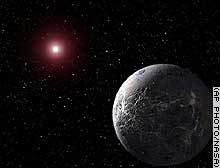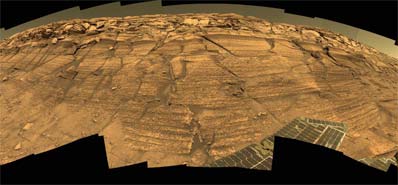Getting Closer...
We are getting closer to the goal of finding a distant world pretty similiar to good old Earth....WASHINGTON (Reuters) -- A new planet-hunting technique has detected the most Earth-like planet yet around a star other than our sun, raising hopes of finding a space rock that might support life, astronomers reported on Wednesday.
"This is an important breakthrough in the quest to answer the question 'Are we alone?'" said Michael Turner of the National Science Foundation.
"The team has discovered the most Earth-like planet yet, and more importantly, has demonstrated the power of a new technique that is sensitive to detecting habitable planets," Turner said in a statement.
In the last decade, astronomers have detected more than 160 planets orbiting stars outside our solar system. The vast majority of these have been gas giant planets like Jupiter, which are hostile to life as it is known on Earth.
But an international team has detected a cold planet about 5-1/2 times more massive than Earth -- still small enough to be considered Earth-like -- orbiting a star about 20,000 light-years away in the constellation Sagittarius (The Archer), close to the center of the Milky Way.
A light-year is about 6 trillion miles (10 trillion km), the distance light travels in a year.
To find this new planet -- named OGLE-2005-BLG-390Lb -- the team used a technique called gravitational microlensing.
This method uses a network of telescopes to watch for changes in light coming from distant stars. If another star passes between a distant star and a telescope on Earth, the gravity of the intervening star acts like a lens and magnifies the incoming light.
When a planet is circling the closer star, the planet's gravity can add its own signature to the light, the scientists said in research being published in the current edition of the journal Nature.
This kind of light signature was observed on July 11 by a group of telescopes participating in a project known as OGLE, short for Optical Gravitational Lensing Experiment, which sees more than 500 microlensing events each year.
The OGLE observation alerted the planet-hunting telescopes of PLANET (Probing Lensing Anomalies NETwork) and Robonet, which made further observations and on August 10 detected the presence of a previously unknown planet.
Astronomers have been discovering so-called extrasolar planets for the last decade, but most have used a method that looks for a characteristic wobble in stars caused by the unseen planets that orbit around them. This technique has been successful in finding Jupiter-type planets but few with Earth's mass.
However, the microlensing technique may hold promise for detecting more planets like our own, in the habitable zone neither too torridly close nor frigidly far from the stars they orbit, said David Bennett of the University of Notre Dame in Indiana, a member of the PLANET team.
"The main advantage (of microlensing) is the signals for low-mass planets: they're not weak signals, they're just rare," Bennett said by telephone. "If there happens to be a good alignment between a foreground star with its planet and the background source star, then you're able to detect that planet."
Our new home




